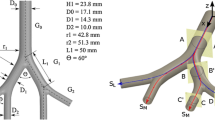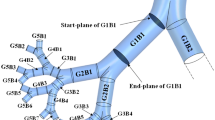Abstract
A simple one-dimensional mass transfer model has been proposed for the oxygen transport through a bronchial tree to alveolar tissues as well as the carbon dioxide removal from the tissues in the human respiratory system. The proposed model mathematically describes the mass transfer between the airway inlet and the red blood cell interior in the pulmonary capillaries. The quasi steady one-dimensional analysis based on the model reveals that the bronchial tree is constructed such that it promotes the easiest access to the external air. Naturally, there exists the optimal number of the bifurcation levels, namely, 23, that yields the minimum overall mass transfer resistance for the mass transport from the external air to the red blood cells.


Similar content being viewed by others
References
Reis AH, Miguel AF, Aydin M (2004) Constructal theory of flow architecture of the lungs. Med Phys 31(5):1135–1140
Andrade JS et al (1998) Asymmetric flow in symmetric branched structures. Phys Rev Lett 81:926–929
Mauroy B, Filoche M, Andrade JS, Sapoval B (2003) Interplay between geometry and flow distribution in an airway tree. Phys Rev Lett 90:926–929
Koulich V, Lage JL, Hsia CCW, Johnson RL Jr (1999) A porous medium model of alveolar gas diffusion. J Porous Media 2:263–275
Koulich V, Lage JL, Hsia CCW, Johnson RL Jr (2002) Three-dimensional unsteady simulation of alveolar respiration. J Biomed Eng 124:609–616
Koulich V, Lage JL (2001) Fundamentals of alveolar diffusion: a new modeling approach. Automedica 20:225–268
Karau KL, Krenz GS, Dawson CA (2001) Branching exponent heterogeneity and wall shear stress distribution in vascular trees. Am J Physiol heart Circ Physiol 280:H1256–H1264
Phillips CG, Kaye SR, Schroter RC (1994) A diameter-based reconstruction of the branching pattern of the human bronchial tree; Description and application. Respir Physiol 98:193–217
Phillips CG, Kaye SR (1995) Diameter-based analysis of the branching geometry of four mammalian bronchial tree. Respir Physiol 102:303–316
Bejan A (2000) Shape and structure, from engineering to nature. Cambridge University Press, Cambridge
Bejan A (2005) Review: the constructal law of organization in nature: tree-shaped flows and body size. J Exp Biol 208:1677–1686
Nakayama A (1995) PC-aided numerical heat transfer and convective flow. CRC Press, Boca Raton
Murray CD (1926) The physiological principle of minimal work in the vascular system and the cost of blood-volume. Proc Acad Nat Sci 12:207–214
Comroe JH, Forster RE, Dubuis AB, Briscoe WA, Carlsen E (1962) The lung clinical physiology and pulmonary functions tests. Year Book Medical Publisher, Chicago, pp 117–121
Author information
Authors and Affiliations
Corresponding author
Rights and permissions
About this article
Cite this article
Nakayama, A., Kuwahara, F. & Sano, Y. Why do we have a bronchial tree with 23 levels of bifurcation?. Heat Mass Transfer 45, 351–354 (2009). https://doi.org/10.1007/s00231-008-0434-0
Received:
Accepted:
Published:
Issue Date:
DOI: https://doi.org/10.1007/s00231-008-0434-0




